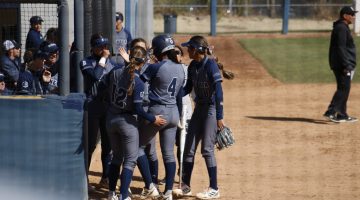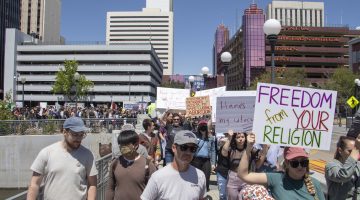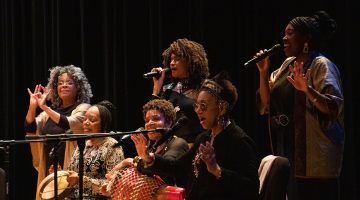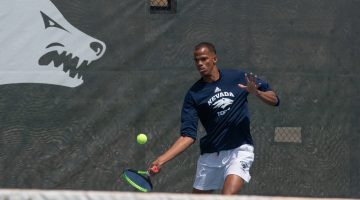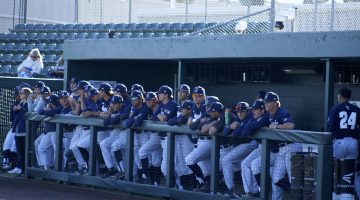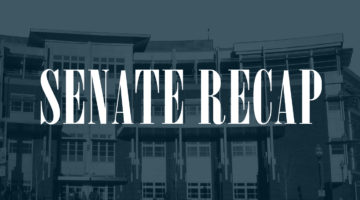
Rachel Spacek/Nevada Sagebrush
From left to right, Daniel Stopka, Grant George, Hayden Cook and Ryan Becker debate for the senate seat for the Divisions of Health Sciences on Thursday, Feb. 23. The debates were recently restructured to allow the candidates the opportunity to ask each other questions.
Campaign signs dot the campus at the University of Nevada, Reno, as candidates running for various positions within the Associated Students of the University of Nevada show off their creativity in an effort to encourage students to support them in the upcoming general election.
Voting for ASUN senate candidates, vice presidential and presidential candidates opens up on Mar. 15 following three nights of senator debates and a night of presidential and vice presidential debates.
The debates have been restructured this year, according to Elections Chair Steve McNeese.
“The restructuring of debates was all based on constructive criticism that we had from the current senate session,” McNeese said. “When they went through the process last year, they had some things to say about how the debates went, they felt that it was a little dull.”
Last year, the debate format had two questions for each candidate. They each went through and answered the question, after which they were allowed a rebuttal. McNeese said most of the time the candidates did not have a rebuttal, but felt that they needed to, or else they would seem as though they didn’t have anything to say. McNeese said the candidates would end up just repeating their answers to the questions.
“[This year] instead of having a rebuttal between every question, we just had one longer rebuttal at the very end, where they could just reference back anything that they said in the entire debate. It got rid of the tedious feeling of repetition,” McNeese said.
In addition to the change to the rebuttal section, in this year’s debates, the elections commission also gave the candidates the opportunity to ask each other questions.
“We haven’t had anything like that before, the thing that made previous elections chairs worry was that if you just opened the floor to the candidates, how can you control it, but this year I wanted to take that risk anyway,” McNeese said. “There are a few stipulations during that four minute period, candidates can ask each other any questions, but it just has to pertain to their platform, goals if elected, and any previous questions in the debate.”
McNeese said the candidates felt robotic with the previous structure and had little interaction with each other.
After the reconstruction of the debate format, McNeese said he was happy with the turnout of the first night of debates. He said in the CABNR debate that the candidates did not have questions for each other, but in the College of Education debate, the candidates asked each other questions that might have been missed otherwise.
In the second night of debates, around 30 people sat in the audience in the Joe Crowley Student Union ballrooms to hear the candidates for the senate seats of the Division of Health Services, the College of Liberal Arts, and the College of Engineering.
“I went to the senator debates and it’s super fun looking back because we were there last year and it’s super fun looking back at all the questions and I didn’t even know he changed up the debates, so when they were like, ‘Hannah Jackson do you want to ask a question?’ to the other candidate, I was super shocked so it was super fun. I had fun going,” said Dennis Green, Senator for the College of Liberal Arts in Wednesday night’s Senate meeting.
ASUN broke the record for people who filed for candidacy last year, but this year the numbers fell short and the College of Journalism does not have any candidates.
This election season started with 39 candidates signed up to run, though that number has dwindled to 33 due to candidates dropping out.
McNeese said there is no definite reason why the number of candidates is so low this election. He said interaction between the current senate and their constituents is important as well as word of mouth.
As far as voter turnout, this election the elections commission’s goal is to have 20 percent participation.
Last year’s voter turnout was 13 percent, which is around the average for the past few years, but the year before was the presidential race between Royce Feuer, who brought a lot of attention to the race and former ASUN President Caden Fabbi.
“It depends on how hard the candidates compete against each other,” McNeese said. “People can sense that and they can see it in the campaigns when you have two candidates who equally want it just as bad and are putting in the same amount of work. It gets people excited, it gets people riled up.”
The race between Speaker of the Senate Noah Teixeira and Sen. Alex Crupi may be a race that will turn out voters due to several tweets that resurfaced this month from Teixeira’s past that have students calling for him to drop out of the race.
The tweets were from 2013 and 2014. In them, Teixeira had used several derogatory terms against African Americans and the LGBTQIA community.
“I’ve seen the tweets and I am really glad that students are interested, that is what the whole elections process is about. It’s about voting for the one person you want to represent you,” McNeese said. “So far the students have really done that.”
While many students have taken to social media to express their distaste for Teixeira’s candidacy, using the hashtag #NeverNoah, many others said in the senate meeting following the resurfacing of the tweets that the comments no longer represent Teixeira and he is still very qualified to run for president.
“I hope that it is an incentive for students to go out and vote,” McNeese said. “The higher voter turnout is, the better representation we have, especially when students are feeling as strongly as they are with current situations. I am hoping that is the case. Whether or not that is true, we’ll see, but every vote is a voice to be heard.”


